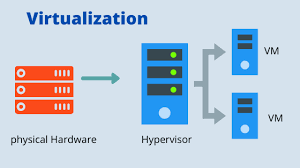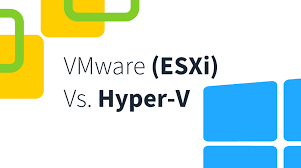Virtualization
Virtualization is the process of creating virtual versions of computing resources such as servers, storage, networks, or operating systems. It allows multiple virtual environments to run on a single physical system, improving efficiency, scalability, and resource utilization.

Running multiple virtual servers on a single physical server (e.g., VMware ESXi, Microsoft Hyper-V, KVM).
Hosting virtual desktops on a centralized server for remote access (e.g., VDI, Citrix).
Abstracting physical networking components to optimize network performance and security (e.g., SDN, VLANs).
Pooling multiple physical storage devices into a unified virtual storage system (e.g., SAN, NAS, cloud storage).
Running applications in isolated environments without installing them on the host OS (e.g., Citrix XenApp, Microsoft App-V).
Running multiple OS instances on the same host using containers (e.g., Docker, Kubernetes).
Benefits of Virtualization
✔ Cost Savings – Reduces hardware and maintenance costs.
✔ Resource Optimization – Maximizes CPU, memory, and storage utilization.
✔ Scalability – Easily allocate or adjust resources as needed.
✔ Security & Isolation – Prevents interference between virtual environments.
✔ Disaster Recovery – Enables quick recovery using snapshots and backups.
Popular Virtualization Tools
🔹 VMware vSphere – Enterprise-grade server virtualization.
🔹 Microsoft Hyper-V – Virtualization for Windows environments.
🔹 KVM (Kernel-based Virtual Machine) – Open-source virtualization for Linux.
🔹 VirtualBox – Cross-platform desktop virtualization.
🔹 Docker & Kubernetes – Container-based OS virtualization.

VMware Vs HyperV
1. Developer & Ecosystem
- VMware vSphere/ESXi: Developed by VMware, widely used in enterprise environments, strong ecosystem with vCenter for management.
- Microsoft Hyper-V: Developed by Microsoft, integrates deeply with Windows Server and Azure, commonly used in Windows-based environments.
2. Performance & Scalability
- VMware: Offers better scalability for enterprise workloads, supports high-performance virtual machines (VMs), and provides advanced memory management features.
- Hyper-V: Good performance, but may require more tuning for high-end workloads compared to VMware.
3. Management & Usability
- VMware: Managed through vSphere/vCenter, which provides a robust and feature-rich UI.
- Hyper-V: Managed via Hyper-V Manager, Windows Admin Center, or System Center Virtual Machine Manager (SCVMM).
4. Licensing & Cost
- VMware: More expensive; requires separate licensing for vSphere, vCenter, and other advanced features.
- Hyper-V: Included with Windows Server at no extra cost (except for advanced management tools like SCVMM).
5. Features
| Feature | VMware vSphere/ESXi | Microsoft Hyper-V |
|---|---|---|
| Live Migration | vMotion | Live Migration |
| High Availability | HA, Fault Tolerance | Failover Clustering |
| Storage Options | vSAN, VMFS, NFS, iSCSI | ReFS, NTFS, SMB 3.0 |
| Nested Virtualization | Yes | Yes |
| GPU Passthrough | vGPU, DirectPath I/O | Discrete Device Assignment (DDA) |
| Backup & Snapshot | vSphere Replication, Snapshots | Checkpoints, Hyper-V Replica |
6. Integration
- VMware: Works well with multi-cloud environments (AWS, Azure, Google Cloud).
- Hyper-V: Deep integration with Microsoft services like Azure and Active Directory.
7. Security
- VMware: Secure Boot, VM encryption, NSX for network security.
- Hyper-V: Secure Boot, Shielded VMs, Windows Defender integration.
Best for:
- VMware: Best for large enterprises, hybrid cloud, and advanced features.
- Hyper-V: Best for Windows-based environments, cost-conscious businesses, and Azure integration.